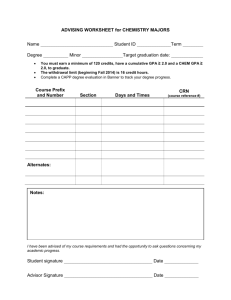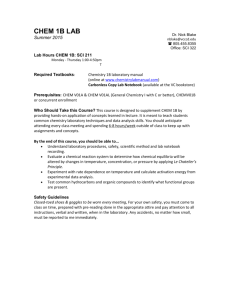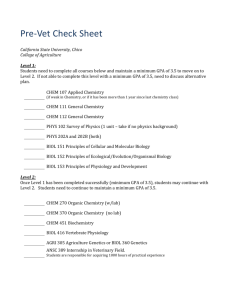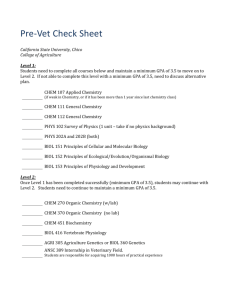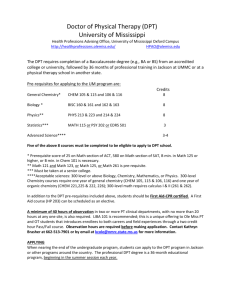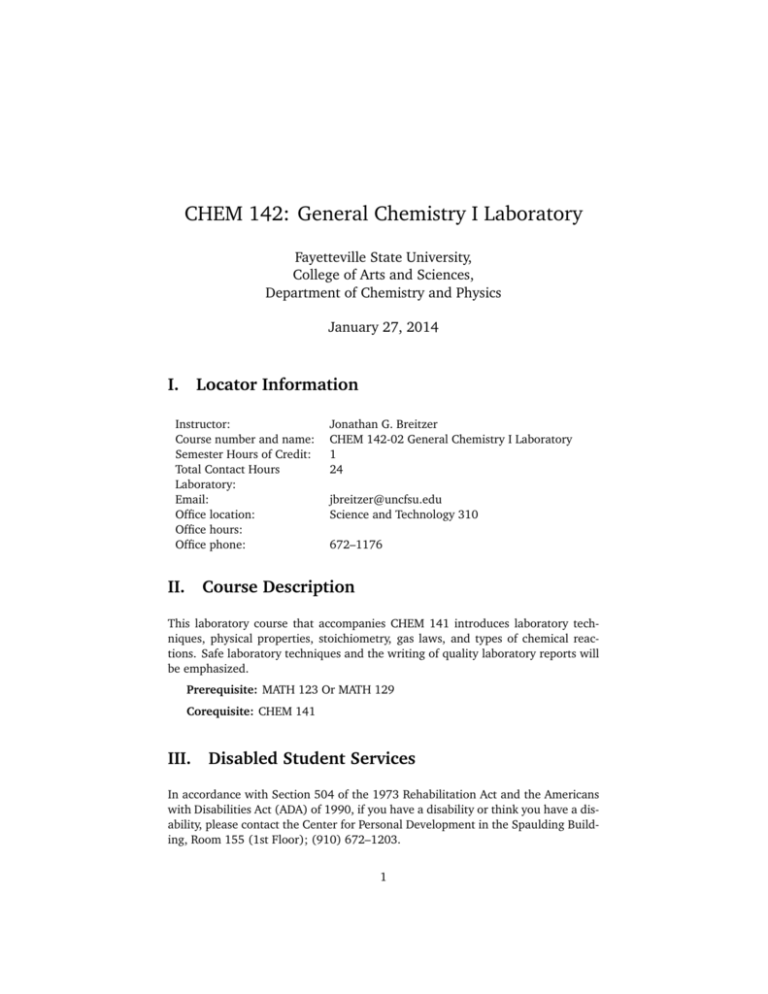
CHEM 142: General Chemistry I Laboratory
Fayetteville State University,
College of Arts and Sciences,
Department of Chemistry and Physics
January 27, 2014
I.
Locator Information
Instructor:
Course number and name:
Semester Hours of Credit:
Total Contact Hours
Laboratory:
Email:
Office location:
Office hours:
Office phone:
II.
Jonathan G. Breitzer
CHEM 142-02 General Chemistry I Laboratory
1
24
jbreitzer@uncfsu.edu
Science and Technology 310
672–1176
Course Description
This laboratory course that accompanies CHEM 141 introduces laboratory techniques, physical properties, stoichiometry, gas laws, and types of chemical reactions. Safe laboratory techniques and the writing of quality laboratory reports will
be emphasized.
Prerequisite: MATH 123 Or MATH 129
Corequisite: CHEM 141
III.
Disabled Student Services
In accordance with Section 504 of the 1973 Rehabilitation Act and the Americans
with Disabilities Act (ADA) of 1990, if you have a disability or think you have a disability, please contact the Center for Personal Development in the Spaulding Building, Room 155 (1st Floor); (910) 672–1203.
1
Such disabilities include known or suspected learning disabilities that may require accommodations such as additional time for examinations, as well as chronic
illnesses that could be anticipated to affect attendance. Bear in mind that this laboratory course will involve long periods of standing and use of fine motor skills. Please
bring any concerns to the attention of the Center for Personal Development and
they will inform me (and your other professors) of what accommodations must be
made.
IV.
Textbook
J. H. Nelson and K. C. Kemp, Laboratory Experiments, Chemistry, The Central Science,
11th Edition, Pearson Prentice Hall, 2006.
V.
Student Learning Outcomes
Upon completion of this course, students will:
1. Follow safe laboratory practices:
(a) Be familiar with chemical hygeine.
(b) Be in the habit of wearing the appropriate personal protection equipment.
(c) Be familiar with the proper use of safety equipment.
(d) Consistently observe administrative controls.
2. Develop good laboratory techniques:
(a) Be able to use volumetric glassware (pipets, volumetric flasks, burets)
to get consistent results.
(b) Know when precise, accurate results are necessary—and when they are
not necessary.
(c) Make good use of time in the laboratory.
(d) Use a laboratory notebook consistently, recording data and observations.
3. Be able to report data in the format of a scientific paper:
(a) Write an experimental procedure that follows a logical sequence.
(b) Indicate the correct kind of details in the experimental procedure.
(c) Write a report free of spelling and grammatical errors, in the proper
tense and voice, and with units written properly.
(d) Indicate results in the form of tables, with graphs used as appropriate.
(e) Write an abstract and introduction that has the correct kinds of information.
2
Grade
Att
Earn
GPA h
QP
A
B
C
D
F
W
4
4
4
4
4
4
4
4
4
4
0
0
4
4
4
4
4
0
16
12
8
4
0
0
VI.
Figure 1: Hours and points earned for
different grades in this course. Your GPA is
Quality Points (QP) divided by GPA Hours
(GPA h). This course, being a 4-credit
course, is weighed more heavily than a 3credit course. A “W” grade does not affect
your GPA (GPA h is zero), but it still counts
as attempted hours.
Course Requirements and Evaluation Criteria
University grades
Withdrawing from a class is a popular choice for students wishing to save their GPA,
but it is problematic for the following reasons:
• You are wasting time and money: you may be delaying completion of your
degree, and you still have to pay the tuition.
• There is a limit of five withdrawals; the sixth and thereafter become F grades.
• If you have 140 Attempted Hours, any additional will cost you 50% extra.
• If you receive financial aid, the limit is 180 Attempted Hours.
• You risk losing your financial aid if you have earned fewer than two-thirds of
the credits you attempted; they’re starting to get pretty strict about this now.
If you are repeating this course, please make sure your advisor submits the
Course Repeat Form so that the earlier grade is excluded from your GPA calculation. In so doing, the Quality Hours (and Quality Points, if any) from the earlier
course will be removed, but the Attempted Hours remain. Please be advised that
you have a limit of five course repeats; beyond that, you may still repeat a course
as necessary to earn credit but the earlier grade will no longer be excluded.
Class Attendance
The following is the University policy:
Students are expected to attend all class meetings, laboratories, and other instructional sessions for all courses in which they are enrolled. Students are also expected
to arrive to class on time and remain in class for the entire scheduled period. When
students must miss class(es) for unavoidable reasons, i.e., illness, family emergencies,
or participation in official university sponsored activities, they are responsible for informing faculty of the reasons for the absences, in advance if possible, and completing
3
Item
%
Laboratory reports
Lab exam
Lab attendance
Total
65
10
25
100
Figure 2: Grade distribution
all missed assignments. Faculty members will indicate in their syllabi the conditions
for making up missed assignments.
During the first half of the semester, faculty will assign an interim grade of “EA,”
Excessive Absences, for students whose class absences exceed 10% of the total contact
hours for the class. Students who receive EA interim grades must either withdraw from
the class or resume attendance. Students who resume attendance must consult with
the instructor about completion of missed assignments. The EA is not a final grade, so
students who are assigned an interim grade of EA, but do not withdraw from the class,
will receive a final grade based on the evaluation criteria for the class.
If you know when you must miss my class, just email me. If it’s for a University
function, the Provost should have informed me and your other professors, but email
me anyway to be sure. You will be expected to make up missed labs in another section.
Grade Distribution
The grade distribution is given in Table 2.
Laboratory reports
Your laboratory reports will be graded based on a rubric that details, section by
section, what should go into a report. The goal here is for students to be able to write
lab reports that follow the usual guidelines of good writing (grammar, punctuation,
subject-verb agreement, and so on) as well as practices that are specific to chemistry.
The expectation is that drafts will be submitted prior to the final report.
Laboratory reports will be typed and will consist of the following:
1. Title and authors
2. Experimental section
(a) Materials and methods (first paragraph)
(b) Procedure (rest of section)
4
3. Results
Label the experimental section and results with headers (“Experimental”, “Results”). For the experimental section, begin with the type of equipment used (as
appropriate), then describe the procedure. Do not label the paragraphs within the
experimental section or number the steps in the procedure. Instead, write it out in
paragraph form in past tense, passive voice. Some examples:
• The water was boiled for 5 min.
• Copper (0.5 g) was treated with HNO3 (15 mL).
• The temperature was read when the thermometer reading stopped changing
(approx. 5 min).
• The color of the potassium permanganate was purple.
Do not start a sentence with a number; instead, indicate amounts in parentheses. Use proper symbols for SI units, and use capital L for liter. Put a space between
a number and its unit, but try to avoid a line break at that space. For times, use s,
min, h, and d; no periods unless at the end of a sentence. Use formulas or names of
your compounds, but do not capitalize the names of compounds (unless of course
the first word begins a sentence). Always indicate times, temperatures, and observations; but when describing colors, keep the number of “crayons” in your box to a
minimum: “purple”, not “mauve” or “aubergine”; “red”, not “crimson”, and so on.
Although observations go in the experimental section, data (results) do not; that’s
what the Results section is for.
For the results section, put your data in tabular and, if necessary, graphical form.
Describe in a narrative what the data mean and what you can conclude.
Exams
Exams will be both written and “practical.” The practical portions will require students to carry out a brief laboratory procedure, and will be evaluated based on
accuracy and good technique.
Final exam
There will be two laboratory examinations given during the semester, as listed in
this schedule. However, there will be no final exam during final exam week for the
following reasons:
• The odd time that this class meets might result in conflicts with other final
exams.
5
• There was no separate final exam for the laboratory portion when CHEM 141
and CHEM 142 were offered together as one course (CHEM 140).
• There is already adequate time built into the schedule for assessment.
My sincerest apologies for the disappointment.
Laboratory notebook
Your laboratory notebook will be evaluated periodically for completeness. The notebook must be an original record of what procedures you followed and the data you
took. It is more important that it be original than neat. You are not to record data
on scraps of paper to be transcribed later; however, it is okay to make a data table
ahead of time.
Campus shutdown
In case of an emergency that results in a closure of campus, such as a hurricane
or epidemic, instruction will continue; online delivery will be used to the maximum
extent possible. This is true even for laboratory courses: sample data and laboratory
notebook notes will be provided, if necessary, for you to type a laboratory report.
Classroom decorum
We have a lot of material to cover, so if you have questions, write them down in
your notes. I will periodically ask if you have questions; save them for then. Please
try to remember to turn off your cell phones or put them on vibrate.
VII.
Course Outline
The topics covered will be as follows:
Week
1
2
3
4
5
6
Laboratory exercise
Safety Briefing
Introduction to Measurement
Physical Properties
Determination of the Formula of a Hydrate
Determination of a Chemical Formula
Chemical Reactions of Copper
Continued on next page.
6
Week
7
8
9
10
11
12
13
14
15
VIII.
Laboratory exercise
Identification of Ions in an Unknown Solid
Laboratory Exam
Concentration and Light Absorption
The Molecular Weight of a Vapor
Specific Heat (to be added to lab manual)
Line Spectra Demo (not in lab manual)
Lewis Structures and the VSEPR Model (activity)
Problem-Solving Session
Lab check-out and lab exam
Teaching Strategies
In teaching this course, the instructor will make use of the hands-on exercises to
emphasize the concepts learned in the classroom. Laboratory skills, however, also
involve physical manipulations and motor skills, which do not always correlate to
book knowledge. Therefore, students will be given ample opportunities to practice
these skills.
IX.
Bibliography
Some references:
J. W. Hill, R. H. Petrucci. General Chemistry: An Integrated Approach. 2nd Ed. Prentice
Hall (1999).
R. Chang. Chemistry. 6th Ed. McGraw-Hill (2000).
P. Atkins, L. Jones. Chemistry: Molecules, Matter, and Change 3rd Ed. Freeman (1998).
S. S. Zumdahl, S. A. Zumdahl. Chemistry. 5th Ed. Houghton Mifflin (2000).
www.webelements.com has been a periodic table on the Web for a long time. There
are obviously a huge number of websites out there when it comes to chemistry.
Wikipedia is also quite reliable (generally only experts in the field bother writing
Wikipedia articles). Keep in mind that, as an encyclopedia, it is not intended to be
a primary reference, but any good article should cite its sources.
7

